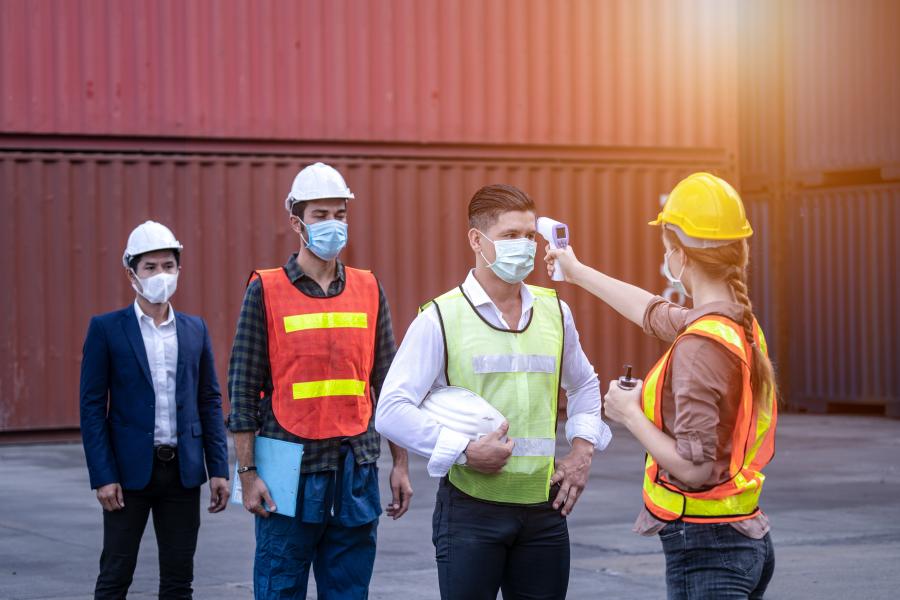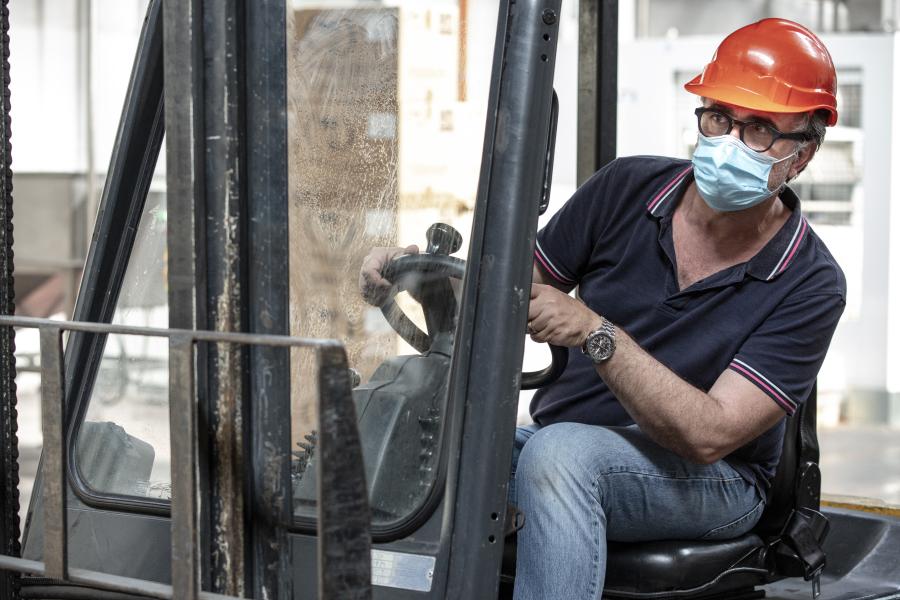The coronavirus is a fact of life on the construction job site this year, and contractors have been forced to change the way they complete projects as a result. It is an ongoing challenge as the industry conditions itself to new approaches to work and personal safety. But best practices and ingenuity have advanced safety and efficiency on the construction job site.
Beyond social distancing, sanitizing and personal protection equipment (PPE), contractors and site owners are adopting site safety protocols for tracking traffic and materials; integrating apps, drones and wearables to monitor employee distancing and exposure; and expanding daily routines to include temperature checks and limit in-person meetings.
"Responsible contractors are hungry to publicly prove they can work safely and prevent the spread of COVID-19 while supporting the nation's critical infrastructure and providing much-needed income for the people who work on those projects," wrote Jordan Hollingsworth, field operations manager of Safety Management Group, Indianapolis, Ind., in a company blog post.
"After all, the construction industry employs almost 10.7 million people in the United States," he added.
Massman Construction, Overland Park, Kan., is clear about its company-wide safety policy. "The Massman Safety and Health Plan is a living document that is updated frequently based on project-specific requirements for safety, security and environmental stewardship. The plan outlines the written program that assists our project teams in preventing incidents and injuries on our project sites."
Contractor Conquers Challenges
Tempe, Ariz.-based Sundt Construction chose "to get out in front" of the challenge, taking a direct approach to the coronavirus. "Construction firms have been given a tall order: To maintain workers' safety during a pandemic while also building essential structures that allow society to function," the company stated in a press release on its pandemic response.
"In more ways than one, Sundt is taking a hands-on approach to keeping our employee-owners safe on the job site."
Besides several company-wide response measures, Sundt is keeping every project as sanitary as possible. "With construction deemed essential, we needed to do the right thing and get out ahead of this," said Omar Percy, health safety & environment (HS&E) manager of the Sundt Transportation Group..
The problem? Most cleaning and hygiene supplies were sold out, not just in certain regions but across the country. "So, we got on the phones, the whole HS&E team, and started calling as many different vendors as we could to get the supplies our projects needed."
Priority was finding enough hand sanitizer for every Sundt field employee and subcontractor. Shawn Werner, concrete health safety & environment (HS&E) manager was introduced to an industrial cleaning supply company with operations in Tempe, Denver and El Paso.
The company was just starting to produce hand sanitizer, a shift that many made this spring to meet current demand. Soon after that conversation, Sundt received its first order of five 55-gal. drums of sanitizer at its Phoenix warehouse. The warehouse manager and crew quickly sought the most efficient method to get the material into 4-ounce bottles for distribution to projects.
Cutting one drum in half, the crew built a drip system to expedite the process. In less than 24 hours of receiving the shipment, the team had bottled, labeled and shipped more than 1,170 bottles to company project sites across multiple states. Within a week, more than 4,000 bottles were distributed so that every employee on a Sundt job site had their own.
Another essential jobsite safety measure is disinfecting, especially for high-contact spaces and surfaces. On construction sites, these include work areas as well as tools and equipment.
Terry "Zeke" Smith, Sundt project HS&E manager, tracked down more than 200 gal. of high-power disinfectant concentrate. In less than a week's time, Smith was able to send it to operations in Phoenix, El Paso and San Antonio for mixing and redistribution to all Sundt projects.
"This virus is going to be part of our world for the foreseeable future," said Percy. "And we're learning a lot about how resilient we are, how we can respond individually, and how we need to adapt as a company to protect our people. So far, our projects and support teams have done a great job."
Implementing Mitigation Plan
By now, all construction contractors should have a coronavirus mitigation plan in place for both the office and the job site. The site-specific health and safety plan will address company-wide safety precautions, a timeline for implementation, any other pandemic-related issues pertaining to the job site.
Many contractors have taken their mitigation plan much further, and made it available to both employees and clients. In some instances, the public has access to the company's policy information via the corporate website.
The Centers for Disease Control (CDC) recommends maintaining healthy business operations by:
- Designating a safety and health officer at every job site to respond to COVID-19 concerns, and make sure employees know who that person is.
- Implementing flexible sick leave and supportive policies and practices. Draft non-punitive emergency sick leave policies if sick leave is not offered to some or all employees.
- Informing fellow employees of any possible exposure, but maintain confidentiality as required by the Americans with Disabilities Act (ADA).
Westerville, Ohio-based Kokosing Construction has a detailed plan for every possible issue related to COVID-19, from CDC protocols, to travel policy during the pandemic. The lengthy plan, posted on the company's website, projects a corporate focus "on keeping people healthy and making sure we can continue providing services to our project owners."
According to the CDC, your company's health and safety plan should be shared with employees in languages everyone understands and should:
- Encourage sick employees to stay home until discontinuation criteria are met.
- Minimize face-to-face contact for employees at higher risk, assign them work tasks to maintain at least 6 ft. from others, or have them telework.
- Provide soap and clean running water for washing, and materials for drying, employees' hands. Another option is to provide alcohol-based hand sanitizers at multiple stations.
- Install temporary or mobile handwashing stations with single-use paper towels, or provide a 5-plus gal. bucket with a lid and tap for handwashing. The tap should be regularly cleaned and disinfected, and fresh clean water provided daily.
- Restock stations during the day.
- Institute measures to physically separate and increase distance between employees, such as modifying work schedules to stagger work, providing alternating workdays, or accommodating extra shifts to reduce the total number of workers on a job site.
- Rearrange administrative areas and breakrooms for 6 ft. of distance. Install shields or barriers where possible.
- Avoid in-person meetings/trainings whenever possible. Reduce the number of meeting participants.
A cleaning and sanitation schedule should be added to the overall project schedule, suggests Safety Management. Frequently-touched items, such as handrails, doorknobs, locks and latches, take priority.
Worker education should address cross-contamination, with frequent cleaning of smartphones, computers, tablets, keyboards, pens and especially tools.
Deliveries should be cleaned before being used, and door handles and gear knobs on delivery vehicles should also be sanitized as well.
Controlling Job Site
Safety Management advises limiting the number of jobsite visitors and their movement. Fencing, no-contact card readers, and modular turnstiles and guard station can help. Here are other suggestions:
- Screen workers and visitors with devices such as no-contact thermometers or thermal imagery cameras to verify they do not have a fever.
- Plan jobsite deliveries in conjunction with contact and cleaning protocols. Identify specific laydown and staging areas. Paint lines to limit areas for gang boxes and material sources. You can separate crew members from staging areas with jersey barriers.
- Keep trash in specific spots where it can easily be transported from the site. Have delivery personnel stay in vehicles and minimize their contact with site workers.
- Assess the site for physical distancing by limiting the potential for workers to gather (including construction equipment and site trailers. Alleviate potential choke points and install physical barriers and signage to restrict access to closed or confined spaces.
- Mark site trailers and break areas for proper distancing. Eliminate community food and lunch areas, and remove coffee pots, water dispensers, microwaves and other shared appliances from break areas, suggests Safety Management.
- Aerial lifts and other equipment should be used by just one person at a time, unless additional PPE is worn.
- Shared tools should be eliminated wherever possible and all tools should be cleaned regularly. Any shared equipment should be disinfected before and after each use. Disinfectant wipes should be readily available.
- Crew members should wash or sanitize their hands before and after use of tools or equipment. Leave tools to rest for three days when possible.
Biting Tech Bullet
If the tech industry wanted to burrow deeper into the construction market, the coronavirus has presented a win-win opportunity for both sectors to help each other. The construction industry could benefit from automation as it emerges from the pandemic while tech companies explore new applications for their devices and services.
General Motors has developed an automated kiosk for temperature scanning, software for contact tracing, and a mobile app for touchless printing.
For temperature scanning, GM integrates the operation of an infrared thermal camera with a computer and monitor. The system automatically detects when someone has stepped in front of the camera and checks for an elevated skin temperature, indicating it is either safe to proceed or the person is in need of further evaluation.
The process can take as little as one to two seconds, relieving congestion at workplace entry points and reducing physical contact between workers. The scanning is also effective when the worker is wearing a mask or face covering.
GM also made improvements to its COVID Watch, an open-source contact tracing application, adding real-time social distance alerts, boosting performance on both iOS and Android devices and adding support for Bluetooth beacons.
The company also is testing a mobile app for contact tracing that would create a record for the employee, listing other users with whom he or she has been in contact.
It can help medical staff reach employees that had contact with a worker testing positive for COVID-19, while maintaining privacy and security. The app also constantly computes the physical distance between users and can send an alert to help encourage safe behavior.
The International Transport Forum (ITF) has tracked the growing use of drones to monitor communities for social distancing. It stands to reason they are used on construction sites for the same, as well as tracking jobsite traffic, material deliveries and visitors.
More sophisticated applications noted by ITF include the installation of thermal cameras on drones to detect infected crew members via body temperature.
Wearables are currently being used for the same types of applications. A Canadian company has created a device that can be worn on the wrist, around the neck or in a pocket, specifically for COVID-19 contact tracing.
Software developers are getting in on the act, too. Cloud-based solutions allow the sharing of updates with workers and monitoring of the virus's infection status to determine who is available to work.
With these apps, crew members can self-report any symptoms of the virus, or potential exposure, using their smartphones. Dashboards show which workers have completed a self-assessment form, how many are symptomatic or at risk and other related metrics.
Managers also can upload employee e-mails to send out group communications, send company and government updates to employees, and provide a simple self-assessment form for daily reporting.
"Safety looks different now. There's no way around it," said Percy. He believes the construction industry must "treat our COVID-19 preventive and protective measures just like we would fall protection or trench safety." CEG
Today's top stories




















